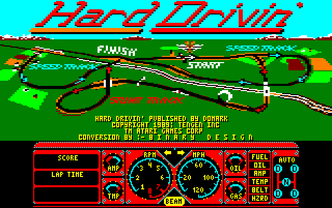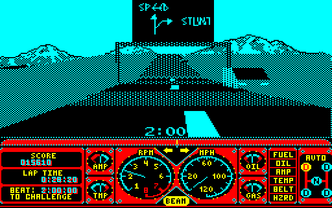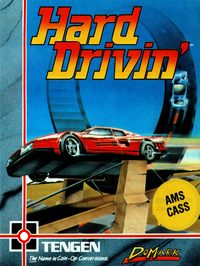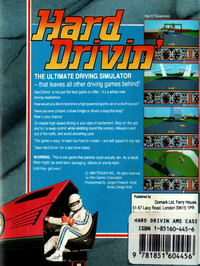Navigation:
Hard Drivin' Amstrad CPC
This game entry is not "published" yet and will not appear in game browers by default! (Edit and set publish = 1)
THE ULTIMATE DRIVING SIMULATOR - that leaves all other driving games behind! Hard Drivin' is not just the best game on offer - it's a whole new driving experience. How would you like to test drive a high powered sports car on a stunt course? Have you ever jumped a draw bridge or driven a loop-the-loop? Now's your chance! Or maybe high-speed driving is your idea of excitement. Step on the gas and try to keep control while skidding round the corners. Weave in and out of traffic and avoid oncoming cars! This game is easy to learn but hard to master - and will appeal to any age. Take Hard Drivin' for a test drive today!
WARNING: This is one game that parents could actually win. As a result there might be short-term damaging effects of young egos.... Until they get even! — Cassette cover
Hard Drivin' is a driving arcade game that invites players to test drive a high-powered sports car on stunt and speed courses. The game featured one of the first 3D polygon driving environments via a simulator cabinet, rendered with a custom architecture. The force feedback, car physics simulator, game design and most game programming were done by Max Behensky. According to the in-game credit screen, Hard Drivin' was designed by two teams working concurrently in the United States and Ireland.
Hard Drivin' was released in 1989, when arcade driving games were implemented with scaled 2D sprites and when filled-polygon 3D graphics of any kind were rare in games. Pole Position and OutRun are classic examples of driving games using scaled 2D sprites.
In total, there were 15 official releases for the arcade, counting 11 cockpit and 4 compact versions, including various British, German and Japanese versions. The game was ported to various 8- and 16-bit platforms in 1989/1990, including the Amstrad CPC, Mega Drive / Genesis, and later to the GameCube, PlayStation 2 and Xbox (Midway Arcade Treasures 2 collection) in 2004.
Source:Wikipedia








